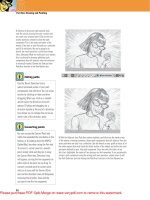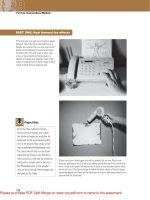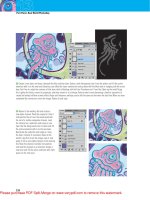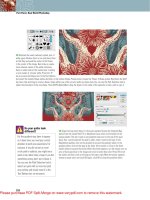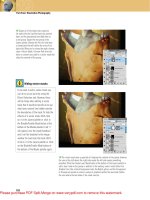Photoshop CS4 Studio Techniques- P4 pptx
Bạn đang xem bản rút gọn của tài liệu. Xem và tải ngay bản đầy đủ của tài liệu tại đây (1.61 MB, 30 trang )
76
Chapter 2 Selection Primer
Figure 2.59 You can view your selection composited against different backgrounds. (©2008 Dan Ablan.)
Modify
The features in the Modify menu (Select > Modify) have
helped artists out of many sticky situations. At fi rst glance,
it might not be obvious why you would ever use these com-
mands, but they’ll be very handy as you continue through
the book. The following list describes the commands:
. Border: Selects a border of pixels centered on the cur-
rent selection. If you use a setting of 10, the selection
will be 5 pixels inside the selection and 5 pixels outside
the selection. You can use this command to remove
pesky halos that appear when you copy an object from
a light background and paste it onto a darker back-
ground (Figures 2.60 and 2.61).
. Smooth: Attempts to round off any sharp corners in
a selection (Figure 2.62). This trick can be especially
useful when you want to create a rounded-corner
rectangle.
77
I: Working Foundations
Figure 2.60 The original selection.
(©2008 Dan Ablan.)
Figure 2.61 A 10-pixel border. Figure 2.62 Smooth: 16 pixels.
. Expand: Enlarges the current selection while attempt-
ing to maintain its shape (Figure 2.63). This command
works well with smooth, freeform selections, but it
might not be the best choice for straight-edged selec-
tions because the selection might expand beyond the
corners of the image.
. Contract: Reduces the size of the current selection
while attempting to maintain its shape (Figure 2.64).
The highest setting available is 16. If you need a higher
setting, just use the command more than once.
Figure 2.63 Expand: 12 pixels. Figure 2.64 Contract: 12 pixels.
78
Chapter 2 Selection Primer
. Feather: Unlike the Feather option in the selection
tools, this command affects only the selection that’s
currently active; it has no effect on future selections.
You can’t reduce the amount of feathering with this
command once it’s applied. Therefore, if you apply
it once with a setting of 10 and then try it again on
the same selection using a setting of 5, it will simply
increase the amount again. It’s just like blurring an
image—each time you blur the image, it becomes more
and more blurry.
You might prefer using this command instead of enter-
ing Feather settings directly into the tool’s options bar
(where they affect all “new” selections). If you enter
values directly, days later you might not remember that
you turned on that setting, and you’ll spend hours
trying to select an intricate object. By leaving the tools
set at 0, you can press Shift-F6 to bring up the Feather
dialog and enter a number to feather the selection.
Because this technique affects only the current selec-
tion, it can’t mess up any future selections.
The problem with the Feather command is that there’s
no way to tell if a selection is feathered by just looking at
the marching ants. Not only that, but most people think
the marching ants indicate where the edge of a selection
is, and that’s simply not the case with a feathered selec-
tion. In Figure 2.65, the marching ants actually indicate
where a feathered selection is halfway faded out. It’s
much better to use the Refi ne Edge command (Select >
Refi ne Edge) or the Refi ne Edge button.
Grow
The Grow command (Select > Grow) searches for colors
that are similar to an area that has already been selected
(Figures 2.66 and 2.67). In effect, it spreads the selection
in every direction—but only into areas that are similar in
color. It won’t jump across areas that are not similar to the
ones selected. The Grow command uses the Tolerance
setting that’s specifi ed in the Magic Wand options bar to
determine the range of colors for which it will look.
Figure 2.65 The selection area is out-
side the image because of a feathered
selection.
79
I: Working Foundations
Figure 2.66 The original selection. (©2008 Dan Ablan.) Figure 2.67 The selection after choosing Select > Grow.
Similar
The Similar command (Select > Similar) works like the
Grow command except that it looks over the entire docu-
ment for similar colors (Figures 2.68 and 2.69). Unlike
the Grow command, the colors that Similar selects don’t
have to touch the previous selection. This feature can be
very useful when you’ve selected one object out of a group
of same-colored objects. For example, if the image shows
a herd of gray elephants standing in front of a lush green
jungle, you can select the fi rst elephant and then choose
Select > Similar to get the rest of the herd (provided, of
course, that they’re all a similar shade of gray). The same
trick works for a fi eld of fl owers, and so on.
Figure 2.68 The original selection. (©2008 Dan Ablan.) Figure 2.69 The selection after choosing Select > Similar.
80
Chapter 2 Selection Primer
Transform Selection
After making a selection, you can scale, rotate, or distort it
by choosing Select > Transform Selection. This command
places handles around the image. By dragging the handles
and using a series of keyboard commands, you can distort
the selection as much as you like. Look at the neat stuff
you can do with Transform Selection:
. Scale: To scale a selection, drag any of the handles.
Dragging a corner handle changes width and height at
the same time. (Hold down the Shift key to retain the
proportions of the original selection.) Dragging a side
handle changes either the width of the selection or its
height. This feature can be a great help when working
with elliptical selections because it lets you drag the
edges of the selection instead of its so-called corners
(Figure 2.70).
. Rotate: To rotate the selection, move your cursor a little
bit beyond one of the corner points; the cursor should
change into an arc with arrows on each end. You can
control where the pivot point of the rotation will be by
moving the crosshair that appears in the center of the
selection (Figure 2.71).
. Distort: To distort the shape of the selection, hold
down the Command/Ctrl key and then drag one of the
corner points. Using this technique, you can drag each
corner independently (Figure 2.72).
You can also distort a selection so that it resembles
the shape of a road vanishing into the distance. Drag
one of the corners while holding down Shift-Option-
Command on the Mac or Ctrl-Shift-Alt in Windows
(Figures 2.73 and 2.74).
To move two diagonal corners at the same time, hold
down Option-Command on the Mac or Ctrl-Alt in
Windows while dragging one of the corner handles.
Finalize your distortions by pressing Return/Enter (or
by double-clicking inside the selection). Cancel them
by pressing Esc.
Figure 2.70 The original selection. (©2008 Dan
Ablan.)
Figure 2.71 After choosing Select > Transform to
scale the selection.
Figure 2.72 Rotating and scaling the selection.
Control-click/right-click while
transforming a selection to choose
the type of distortion you want to
perform.
81
I: Working Foundations
Loading and Saving Selections
If you’ve spent hours perfecting a selection and think
you might need to use it again in the future, apply the
Save Selection command (Select > Save Selection) to
store the selection as an alpha channel. Don’t worry, you
don’t need to know anything about channels to use these
commands—all you have to do is supply a name for the
selection. If you want to fi nd out more about working
with channels, check out the bonus video “Channels” at
www.danablan.com/photoshop.
Figure 2.73 The original selection.
(©2008 Dan Ablan.)
Figure 2.74 Dragging the corner with
Command/Ctrl.
82
Chapter 2 Selection Primer
These saved selections remain in your document until you
manually remove them using the Channels panel. They
won’t be saved on your hard drive until you actually save
the entire fi le. Only the Photoshop (.psd), Large Docu-
ment Format (.psb), Photoshop PDF (.pdf), and TIFF (.tif)
fi le formats support multiple saved selections.
When you want to retrieve a saved selection, choose
Select > Load Selection and pick the name of the selection
from the Channel pop-up menu (Figure 2.75). When you
use this command, it’s just like re-creating the selection
with the original selection tool you used, only a lot faster.
Quick Mask Mode
Earlier I mentioned that the marching ants marquee
doesn’t accurately show what a feathered selection looks
like. Quick Mask mode can show what a feathered selec-
tion really looks like and can also help in creating basic
selections. The Quick Mask icon is located directly below
the foreground and background colors in the Tools panel
(Figure 2.76).
To see how Quick Mask works, fi rst make a selection by
using the Marquee tool. Turn on Quick Mask mode by
clicking the Quick Mask icon (or just press Q). In Quick
Mask mode, the selected area should look normal and all
the unselected areas should be covered with a translucent
color (Figures 2.77 and 2.78).
Figure 2.75 Once a selection is saved,
you can load it for future work.
Figure 2.76 The Quick Mask icon is at
the bottom of the Tools panel.
83
I: Working Foundations
Figure 2.77 A selection shown in
Standard mode. (©2008 Dan Ablan.)
Figure 2.78 The selection from Figure
2.77, shown in Quick Mask mode.
Now that you’re in Quick Mask mode, you no longer need
to use selection tools to modify a selection. Instead, use
standard painting tools, painting with black to take away
from the selection or white to add to it. When you’re done
modifying the selection, switch back to Standard mode, and
the marching ants will reappear (Figures 2.79 and 2.80).
Figure 2.79 A selection modified in
Quick Mask mode.
Figure 2.80 End result after switching
back to Standard mode.
84
Chapter 2 Selection Primer
Now let’s see what feathered selections look like in Quick
Mask mode. Make another selection using the Marquee
tool. Choose Select > Modify > Feather with a setting of
10, and then switch to Quick Mask mode and take a look
(Figures 2.81 and 2.82). Feathered selections appear
with blurry edges in Quick Mask mode. This happens
because partially transparent areas (that is, those that
are more transparent than the rest of the mask) indicate
areas that are partially selected (50% transparent means
50% selected).
Figure 2.81 Normal. (©2008 Dan Ablan.) Figure 2.82 Feathered.
The confusing part about this process is that when you
look at the marching ants that appear after you switch back
to Standard mode, they only show where the selection is
at least 50% selected. That isn’t a very accurate picture of
what it really looks like. But in Quick Mask mode, you can
see exactly what’s happening on the image’s edge. If you
want to create a feathered selection in Quick Mask mode,
just paint with a soft-edged brush. Or, if you already have a
shape defi ned, choose Filter > Blur > Gaussian Blur, which
gives you the same result as feathering and shows a visual
preview of the edge.
Selections in Quick Mask Mode
You can even use a selection to isolate a particular area of
the quick mask (Figure 2.83). Quick Mask mode can help
you to create a selection that’s feathered on only one side.
Want to try it? Turn on Quick Mask mode, press D to reset
Figure 2.83 Using a selection in Quick
Mask mode to restrict which areas can
be edited. (©2008 Dan Ablan.)
85
I: Working Foundations
the foreground color, and then press Option-Delete (Mac)
or Alt-Backspace (Windows) to fi ll the quick mask. Next,
choose the Marquee tool and select an area. Now use the
Gradient tool set to Black, White (the third choice from
the left in the Gradient Editor panel) and create a gradi-
ent within the selected area. When you’re done, switch off
Quick Mask mode. To see exactly how this selection will
affect the image, choose Image > Adjustments > Levels
and attempt to lighten that area by dragging the lower-
left slider.
Quick Mask Options
Photoshop also allows you to switch where the color shows
up in a Quick Mask selection. You can specify whether
you want the selected or unselected areas to show up. To
change this setting, double-click the Quick Mask icon and
change the Color Indicates setting (Figures 2.84 and 2.85).
Photoshop uses the term masked areas to describe areas that
are not selected.
You can change the color that’s overlaid on the image
by clicking the color swatch in the Quick Mask Options
dialog. The Opacity setting determines how much you’ll be
able to see through the Quick Mask.
The Next Step
After a few practice rounds with the tools covered in this
chapter, you should be selecting like a pro. We’ll go over
more advanced methods of creating selections in Chapter
9, “Enhancements and Masking.” Meanwhile, it really is
worth spending the time to build up your selection skills;
you’ll use them every day in Photoshop.
Figure 2.84 Changing the Color Indi-
cates setting changes where the color
overlay appears.
Figure 2.85 Quick Mask settings.
This page intentionally left blank
Chapter 3: Layers and Curves 89
Chapter 4: Using Camera Raw 5.0 149
Chapter 5: Adjustment Layers 185
Chapter 6: Sharpening 211
Production Essentials
II
P
P
P
P
This page intentionally left blank
CHAPTER
3
Layers and Curves
90
Many people who excel are self-taught.
—Herb Ritts
Layers and Curves
T
he Layers panel will quickly become familiar. Whether
you’re working on a single image or a complex graphic
for a poster, the Layers panel is your home base for adjust-
ments, masking, blending, and even just simple project
organization.
How Do Layers Work?
At fi rst glance, layers might seem complex, but the idea is
really rather simple: You isolate different parts of an image
onto independent layers so that you can work with them
separately. Think of each layer as a piece of glass, with the
individual layers stacked on top of each other as if they
were separate documents (Figure 3.1). By putting each
image on its own layer, you can change your document’s
look and layout freely without committing to the changes.
If you paint, apply a fi lter, or make an adjustment, it affects
only the layer on which you’re working. If you get into a
snarl over a particularly troublesome layer, just throw it
away and start over. The rest of your document will remain
untouched—safe and handy!
Layers can relate to each other in interesting ways, such
as when you create a mask (hole) in one layer to reveal an
underlying image on another layer. You’ll learn some great
techniques using this concept in Chapter 9, “Enhance-
ments and Masking,” and Chapter 10, “Collage Effects.”
But fi rst, you need to understand the foundations. If you’ve
used layers for a while, you might fi nd some of this chapter
a bit too basic. On the other hand, you might fi nd some
juicy new tidbits.
91
II: Production Essentials
Meet the Layers
Before you jump in and start creating a bunch of layers,
you should get familiar with their place of residence: the
Layers panel (Figure 3.2). You’re going to spend a lot
of time with this panel, so take a moment now to get on
friendly terms with it. It’s not terribly complicated, and
after you’ve used the Layers panel a few times you should
know it like the back of your hand.
As you make your way through this chapter, you’ll learn
more about the Layers panel and the fundamental tasks
associated with it. Now, assuming that you’ve done your
part and introduced yourself to the Layers panel, let’s get
on with the business of creating and manipulating layers in
Photoshop.
Creating Layers
Photoshop automatically creates the majority of the lay-
ers you’ll need. A new layer is added when you copy and
paste an image or drag a layer between documents (we’ll
talk about this later in the chapter). If you’re starting
from scratch, however, just click the New Layer icon at the
bottom of the Layers panel to create a new, empty layer.
Figure 3.1 Think of layers as stacks of
glass that you can blend in all sorts
of ways.
Figure 3.2 A typical Photoshop file
with multiple layers, shown in the
Layers panel.
92
Chapter 3 Layers and Curves
Give it a try now: Choose File > New and create an RGB
document that’s around 400 × 400 pixels in size, with a
transparent background (Figure 3.3). Resolution doesn’t
matter at this point. Click the New Layer icon at the bot-
tom of the Layers panel to create an empty layer. Click
your foreground color and pick out a bright color. Choose
the round Shape tool (Ellipse), which is grouped with
the Rectangle Shape tool, below the Type tool and Path
Selection tool in the Tools panel. In the options bar, click
the Fill Pixels icon (Figure 3.4). Click and drag across your
image to draw a big circle.
Figure 3.4 Click the Fill Pixels icon (on
the far right) in the options bar.
When you’re done with the fi rst shape, create another
layer and use the Rectangle Shape tool to draw a square,
using a different color (Figure 3.5). Finally, create a third
layer and draw a triangle with yet another color. (Create
the triangle by using the Polygon Shape tool and setting
Sides to 3 in the options bar.)
Figure 3.3 Create a new blank image
with a transparent background.
If you hold down the Command/
Ctrl key when clicking the New
Layer icon, the new layer appears
below the active layer instead of
on top of it. The only time this trick
won’t work is when the Background
is active—Photoshop can’t add a
new layer below the Background.
93
II: Production Essentials
You can use this simple document you’ve just created to
try out the concepts in the following sections that describe
the features of the Layers panel. Figure 3.6 shows the three
added layers.
Active Layer
The current layer is highlighted in the Layers panel. To
change the active layer, just click the name of another layer.
Alternatively, Command/Ctrl-click the image while the
Figure 3.5 Draw a colored rectangle
in a new layer.
Figure 3.6 Three layers stacked above
a white Background layer.
94
Chapter 3 Layers and Curves
Move tool is active (press V to activate the Move tool), which
causes the topmost layer containing information under your
cursor to become active. As you Command/Ctrl-click differ-
ent parts of an image (circle, square, triangle in this exam-
ple), watch the Layers panel to see which layer becomes
active. Photoshop allows you to have more than one layer
active at a time, but for now we’ll stick to working with one
layer to keep things simple.
Naming Layers
Photoshop names each layer you create. However, as your
projects become more complex, a stack of layers named
Layer 1, Layer 2, and so on can start to get pretty confus-
ing. To stay organized, name layers as you create them. To
name a layer, click the current layer name twice and type
the new name. (That is, click with a delay: click, wait, click.
A double-click opens the Layer Style dialog, which we’ll
talk about later in this chapter.)
Layer Order
To change the order of layers, drag the name of a layer
above or below the name of another layer in the Layers
panel.
Layers work from the bottom up. Let’s say you load a
graphic or photograph. That’s one layer. Then you cre-
ate a new layer and draw a shape. The topmost layers will
obstruct your view of the underlying images. However,
changing blending modes, creating masks, and other func-
tions make the layers work together, taking them further
than just stacking them one on top of another. But for now,
know that you can reorganize the layers by dragging them
up or down in the Layers panel.
Background Image (Background Layer)
The Background image in Photoshop (which some people
refer to as the Background layer) is a bit different from the
other layers that make up an image. Think of the layers as
individual pages in a pad of tracing paper. The Background
image equates to the pad’s cardboard backing. It might be
Try creating a new layer before
using any of the painting tools or
the Gradient tool. Because these
tools apply changes directly to
the active layer, the changes are
difficult to modify once they’ve
been applied. It’s good working
with a safety net, so before using
these tools, you should create a
new layer where you can easily edit
the changes without disturbing the
underlying image.
95
II: Production Essentials
the same size and it relates to the other pages in the pad,
but it has some qualities that make it quite different.
The Background image has the same limitations as most of
the common fi le formats in use today (such as JPEG and
EPS): It’s always 100% opaque; no part of it can extend
beyond the document’s bounds, and it’s not actually
considered a layer, since most fi le formats don’t support
layers (with a few exceptions such as .PSD and .TIFF). In
fact, that’s why the Background image exists. If all your
document contains is the Background, you still should be
able to save the image in just about any fi le format without
losing information. That’s also why most images start life
as a Background image—because they originated in a fi le
format that didn’t support layers or came from a program
that doesn’t support layers. When you save a layered docu-
ment into a fi le format that doesn’t support layers (such
as JPEG), Photoshop automatically combines all the layers
that make up the image and turns the result into a Back-
ground image (known as fl attening).
The Background image always displays a lock symbol to
indicate that it cannot be repositioned with the Move tool,
moved up or down in the layers stack, or be made trans-
parent. For that reason, many tools will work differently
when the Background image is active. For instance, the
Eraser tool paints with the background color when the
Background image is active, since it can’t make areas of
the Background image transparent.
With all that said, you don’t actually have to have a Back-
ground in your document. If you want to convert the
Background into a normal layer, just change its name.
The Background image must be named “Background” or
it becomes a normal, unlocked layer.
The Eyeballs: What They See Is What You Get
The eyeballs in the Layers panel determine which layers
will be visible in your document as well as which ones will
print. The eyeballs turn on and off in a toggle effect when
you click them: Now you see them, now you don’t.
If your document doesn’t have
a background (because you
accidentally deleted or renamed the
Background image), you can con-
vert one of the existing layers into
a background by choosing Layer >
New > Background from Layer. Just
changing the layer’s name back to
“Background” won’t do the job.
You can change the checkerboard’s
appearance by choosing Edit >
Preferences > Transparency &
Gamut. You can even change it to
solid white by changing the Grid
Size setting to None.
96
Chapter 3 Layers and Curves
If you turn off all the eyeballs in the Layers panel, Photo-
shop fi lls your screen with a checkerboard. This checker-
board indicates that nothing is visible in the document.
(If Photoshop fi lled your screen with white instead, you
might assume that you were looking at a visible layer fi lled
with white.) Think of the checkerboard as the areas of the
document that are empty. When you view a single layer, the
checkerboard indicates the empty areas of that layer. As
you turn on the other layers in the document, the checker-
board is replaced with the information contained on those
layers. When multiple layers are visible, the checkerboard
indicates where the underlying image will not be obstructed
by the elements on the visible layers (Figure 3.7).
Opacity
The Opacity setting at the top of the Layers panel controls
the opacity of the active layer. When this setting is lowered,
the entire layer becomes partially transparent (transparent
is the exact opposite of opaque). To lower the opacity in a
specifi c area rather than the entire layer, lower the opac-
ity of the Eraser tool and then brush across the area of the
layer you want to become more transparent—that is, unless
the Background image is active. If you use the Eraser tool
on the Background image, Photoshop simply paints with
your background color instead of truly deleting areas.
(Remember, the Background image is always opaque.)
To turn off all the visible layers in
the Layers panel, Option/Alt-click
any of the eyeball icons. Option/
Alt-clicking a second time brings
those same layers back into view.
To make all the layers visible/
invisible, Control-click/right-click
an eyeball icon and choose
Show/Hide All Other Layers.
Figure 3.7 When you uncheck a
visibility icon (eyeball) in the Layers
panel, that particular layer no longer
shows in your document.
You can figure out the exact opacity
of an area by Option/Alt-clicking
a layer’s eyeball icon and then
opening the Info panel. Click
the eyedropper in the Info panel
and choose Opacity; you’ll get a
separate readout that indicates
how opaque the area is below your
cursor.
97
II: Production Essentials
Figure 3.8 Painting on a new layer, above the other layers,
obstructs the layers beneath.
Figure 3.9 Lowering the opacity of a layer allows the other
layers to show through.
Try this: Using the document you created earlier in this
chapter, create a new layer, and press B to activate the
Brush tool. Then use any painting tool to brush across the
layer. Now lower the Opacity setting in the Layers panel to
70% (Figures 3.8 and 3.9).
Now let’s compare this effect with what happens when you
lower the Opacity setting of the Paintbrush tool. Create
another new layer; however, this time leave the layer’s
Opacity setting at 100%. Click the Paintbrush tool, change
the tool’s Opacity setting to 70% in the options bar, and
then brush across the layer (just don’t overlap the paint
you created earlier). The result should look like the paint
that appears in the other layer (Figure 3.10).
When you need to position a layer
precisely, lower the Opacity setting
just enough so you can see the
underlying layers. After positioning
the layer, press 0 to bring the layer
back to 100% opacity. For really
precise layer positioning, use the
arrow keys on your keyboard.
Figure 3.10 Painting on a layer with
100% opacity, but with a brush set to
70% opacity, yields the same type of
result as in Figure 3.10.
98
Chapter 3 Layers and Curves
Figure 3.11 Painting on a layer with 100% opacity makes a
solid color covering anything below it.
Figure 3.12 Painting a layer with the Eraser tool set at 30%
opacity removes just a portion of the layer.
Finally, create one more new layer, and paint across it with
the tool’s Opacity setting at 100%. Now brush across an
area with the Eraser tool, using an Opacity setting of 30%
(Figures 3.11 and 3.12).
All of these options do the same thing. You just have to
think a bit: Do you want to apply the Opacity setting to the
entire layer? Use the Layers panel’s Opacity setting. Do
you want to apply the Opacity setting to only part of the
layer? Use the Opacity setting in the tool’s options bar. Do
you want to change the opacity of an area you’ve already
painted? Use the Eraser tool with an Opacity setting.
Moving Layers
If you want to move everything that’s on a particular layer,
fi rst make that layer active by clicking its name; then use
the Move tool (press V) to drag the layer around the
screen. If you drag the layer onto another document win-
dow, Photoshop copies the layer into that document. If you
want to move just a small area of the layer, you can make
a selection and then drag from within the selected area by
using the Move tool.
To change the opacity of a layer
quickly, switch to the Move tool
(press V) and use the number keys
on your keyboard (1 = 10%, 3 =
30%, 56 = 56%, and so on).
99
II: Production Essentials
When the Move tool is active, you can use the arrow keys
on your keyboard to nudge a layer one pixel at a time.
Holding down Shift while using the arrow keys nudges the
active layer 10 pixels at a time.
Selecting Multiple Layers
As you might expect, you can select more than one layer at
a time. Clicking individual layers with no keys held down
causes individual layers to become active. Command/Ctrl-
clicking a layer adds that layer to the other layers that are
selected. To select a range of layers, click the fi rst layer you
want, hold down Shift, and click the last layer you want.
Photoshop selects all the layers between the fi rst and the
last layers you clicked. You can also Shift-Command-click
(Mac) or Shift-Ctrl-click (Windows) within an image while
the Move tool is active to add the layer that appears under
your cursor to the layers that are currently selected. There
is no limit to the number of layers that can be selected at
one time.
Linking Layers
When multiple layers are linked, using the Move tool or
choosing Edit > Transform causes the active layer and all
the layers linked to it to change (as if all the linked lay-
ers were selected). The advantage to linking layers is that
the linking behavior is maintained regardless of which
layer is active. So, if two layers should always relate in size
and position, link them together so that that relationship
remains consistent. To link layers, select the layers and
then click the Link symbol at the bottom of the Layers
panel (Figure 3.13). After linking the layers, moving or
transforming the image while any one of the linked layers
is selected causes all the linked layers to change. To unlink
layers, select the layers you want to unlink and click the
Link symbol again.
Trimming Images in Layers
If you use the Move tool to reposition a layer so that
a portion of the layer extends beyond the edge of the
Many of Photoshop’s features are
unavailable when multiple layers
are selected (such as filters and
adjustments) because they were
designed to work on only one layer
at a time.
Figure 3.13 Linking layers allows
certain behaviors, such as moving or
rotating, to affect all the linked layers.
Linked layers display the link symbol
next to the layer name.
100
Chapter 3 Layers and Curves
document, that portion will no longer be visible, but
Photoshop still remembers the information (Figure 3.14).
If you move the layer away from the edge, Photoshop is
able to bring back the information that wasn’t visible.
You can save a lot of memory by making Photoshop clip
off all the information beyond the edge of the document.
Here’s a little trick for trimming off that fat. Just choose
Select > All and then choose Image > Crop—no more
wasted memory.
The default setting in the Crop tool is to delete the areas
that extend beyond the edge of an image. You can prevent
the Crop tool from deleting those areas by clicking the
Hide setting in the Crop tool options bar (it will be avail-
able only in fi les that contain layers). That option causes
Photoshop to reduce the size of the image based on the
cropping rectangle you specify, but retain the information
that extends beyond the edge of the image.
Extra white space around the edge of an image also wastes
memory (Figure 3.15). Choosing Image > Trim causes
Photoshop to remove any unnecessary white space (Figure
3.16). Just adjust the Based On setting so that Photoshop
will fi nd white information in the image (depending on
which corner of the image contains white), and then spec-
ify which edge of the document you want to trim away—
you can usually leave all four of the Trim Away check boxes
turned on.
Figure 3.14 If an image is moved
beyond the edge of a document,
Photoshop remembers the part that’s
no longer visible—unless you crop it.
A crop rectangle must be drawn
and active for the Show/Hide com-
mands to be visible.
Use the “trim the fat” technique
only if you’re absolutely sure you
won’t need the information beyond
the edge of the document, because
you cannot get it back once you’ve
cropped it (that is, without resort-
ing to the History panel).

